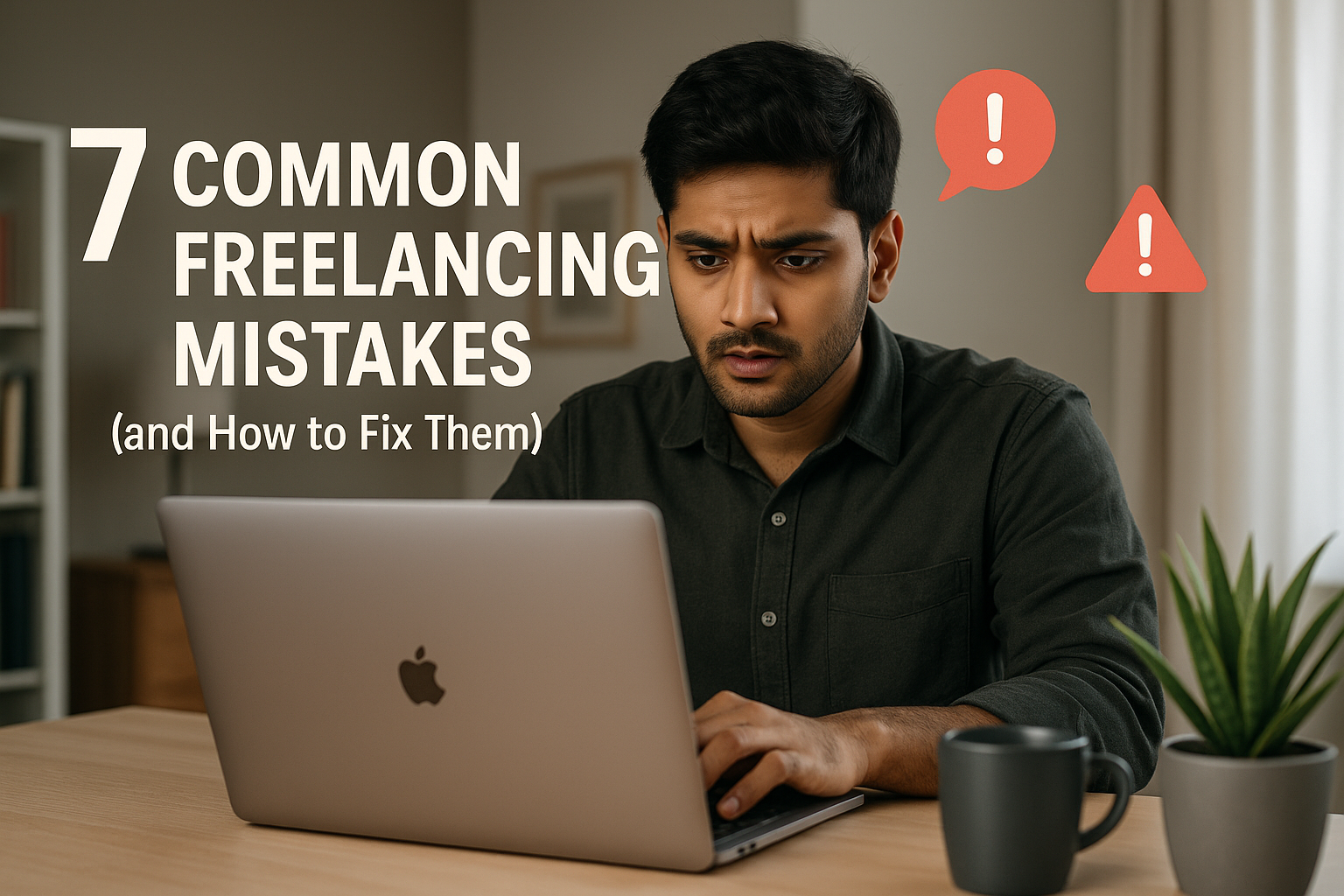Introduction
Freelancing has exploded as a viable career path, especially with the rise of remote work and global demand for digital skills. For Indian freelancers and virtual assistants, this presents an opportunity to tap into high-paying projects and build a sustainable career. Yet, many professionals fall into avoidable traps that hinder growth. If you’re struggling to land freelancing jobs or keep clients long-term, chances are you’re making some common mistakes.

Whether you’re just starting or you’re looking to refine your freelance business, identifying and correcting these errors is essential. Freelance platforms like EMFOB have made it easier to connect with clients, but success still depends on your strategy, habits, and professionalism.
1. Undervaluing Your Services
One of the most common mistakes freelancers make is pricing their services too low, especially early in their careers. Many believe lower prices attract more clients—but this often backfires.
Why It’s a Problem:
It attracts low-quality clients.
It undervalues your expertise.
It leads to burnout and frustration.
How to Fix It:
Research competitive pricing in your niche and region.
Use EMFOB to benchmark what similar freelancers are charging.
Focus on value-based pricing, not time-based pricing.
By positioning yourself as a professional rather than a cheap alternative, you’re more likely to win high-paying projects.
2. Poor Communication with Clients
Even the most skilled freelancer can lose clients due to miscommunication. Remote work magnifies the need for clarity and consistency in updates, deliverables, and expectations.
Symptoms:
Clients frequently request revisions.
Deadlines are misunderstood.
You’re unsure about project expectations.
Fixes:
Schedule regular check-ins via email or Zoom.
Summarize expectations and next steps after meetings.
Good communication turns first-time clients into repeat business, helping you scale sustainably.
3. Ignoring Contracts and Legal Agreements
Too many freelancers rely on informal agreements or verbal commitments. This opens the door to late payments, scope creep, and disputes.
Risks:
Non-payment or partial payment.
Extra work without extra pay.
Legal challenges without protection.
Solutions:
Always use a written contract—many templates are free online.
Include milestones, timelines, revision limits, and payment terms.
Freelance platforms like EMFOB offer built-in contracts and dispute resolution.
A clear agreement sets professional expectations and protects both parties.
4. Taking on Too Many Projects at Once
Freelancers often fear rejecting projects, especially during slow periods. But overcommitting compromises quality and can damage your reputation.
Consequences:
Burnout and health issues.
Missed deadlines.
Poor-quality work and unhappy clients.
How to Fix:
Learn to assess your workload capacity honestly.
Use calendars to map project timelines visually.
Outsource or collaborate when needed—virtual assistants often team up to handle large workloads.
Remember, fewer high-paying projects are better than many low-paying, time-draining ones.
5. Not Investing in Self-Marketing
Waiting for freelance platforms to deliver clients is a passive approach. Building your personal brand is critical for attracting higher-tier opportunities.
Common Pitfalls:
No website or portfolio.
Outdated or unpolished social media profiles.
Lack of client testimonials or case studies.
Fix It:
Optimize your LinkedIn profile with relevant keywords like “virtual assistant,” “remote worker,” or “freelance graphic designer.”
Ask for client testimonials after successful projects.
Marketing yourself positions you for premium rates and long-term contracts.
6. Failing to Upskill or Update Your Knowledge
The digital world evolves fast. Freelancers must continually upgrade their toolkits to stay competitive.
Signs You’re Falling Behind:
Clients ask for skills you don’t have.
You rely on outdated software.
You’re passed over for jobs on newer platforms.
How to Stay Sharp:
Enroll in free or paid online courses on platforms like Coursera, Skillshare, or HubSpot Academy.
Follow top freelancers and blogs in your industry.
Join communities like EMFOB to stay informed on emerging trends.
The more you know, the more valuable you become to clients.
7. Avoiding Feedback and Self-Assessment
Ignoring client feedback is a missed opportunity to improve. Many freelancers shy away from it, fearing criticism.
Dangers:
Repeated mistakes.
Damaged reputation.
Missed chances for growth.
What to Do:
After every project, ask your client what could have gone better.
Send a quick post-project survey.
Use feedback to refine your approach and improve client retention.
Honest feedback, even when critical, is your fastest path to growth.
The Power of Platforms Like EMFOB
Unlike saturated sites like Upwork and Fiverr, EMFOB focuses on connecting quality freelancers—especially Indian virtual assistants—with clients looking for premium talent. It offers tools like:
Escrow-based payments
Built-in contracts
Client reviews
Skill-matching algorithms
If you’re looking to avoid the race to the bottom and access consistent, high-quality freelancing jobs, EMFOB is a platform worth exploring.
FAQs
Q1: How can Indian freelancers secure high-paying freelance jobs?
Build a strong portfolio, upskill regularly, and use trusted freelance platforms like EMFOB to access premium clients.
Q2: What are the most in-demand freelancing skills today?
Skills like content writing, web development, SEO, virtual assistance, and graphic design are always in demand.
Q3: Why are contracts important in freelancing?
They protect both freelancer and client, outline project scope, timelines, and payment terms, reducing disputes.
Q4: How do I stand out on freelance platforms?
Create a compelling profile, tailor proposals, showcase relevant work samples, and gather positive reviews.
Q5: Can I freelance part-time while keeping a full-time job?
Yes. Many remote workers freelance on the side before transitioning into full-time freelancing.
Q6: How do I handle international clients and payments?
Use platforms with built-in escrow or tools like PayPal, Wise, or EMFOB’s payment system for secure transactions.
Conclusion
Freelancing is more than just remote work—it’s a business. By avoiding these common freelancing mistakes, you’re setting yourself up for long-term success. Whether you’re an Indian freelancer starting out or a virtual assistant aiming for high-paying projects, taking control of your career path means being proactive.
From refining your communication to leveraging powerful freelance platforms like EMFOB, your next big opportunity is within reach. Embrace feedback, stay organized, and keep investing in yourself. The freelance world rewards consistency, professionalism, and growth.

![Emfob_Logo[1]](https://emfob.com/wp-content/uploads/2022/09/emfob_sample.png)